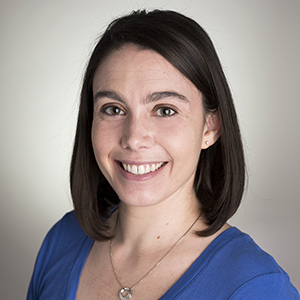Allison Gruber

Associate Professor
Email: ahgruber@iu.edu
Phone: 812-856-2447
Address: 1025 E. 7th St.
Department: Kinesiology
ORCID - 0000-0002-0750-5656
B.S. University of Massachusetts Amherst 2004
M.A. East Carolina University 2007
Ph.D University of Massachusetts Amherst 2012
- Fellow, American College of Sports Medicine
- 2017: Young Scientist Award, Biomechanics Interest Group of the American College of Sports Medicine
- 2016-2020: Co-Chair, Biomechanics Interest Group of the American College of Sports Medicine
- 2012-2014: Postdoctoral Research Assistant, Biomechanics, University of Massachusetts Amherst
- 2009-2011: Student Representative, International Society of Biomechanics Executive Council
Scholarly Interest
Running is one of the most common modes of recreational exercise in the United States. Unfortunately, rates of running related injuries remain high despite technological advances in footwear, knowledge of appropriate training methods, and vast amounts of research pertaining to injury mechanisms. Numerous gait characteristics have been identified as potential risk factors for the development of overuse running injury; however, there is a lack of consistency between studies regarding the kinematic and kinetic patterns and events that may or may not cause running injuries. As a result, it seems that we are no closer to understanding the mechanisms of running injuries or how they can be prevented. My research takes an interdisciplinary approach and uses advanced analysis methods to investigate the mechanisms of running related overuse injuries and the determinants of running economy. I combine biomechanical data with experimental oxygen consumption and substrate utilization data, both experimentally and via musculoskeletal and muscle energetics models, to comprehensively examine the interaction and importance of gait energetics on injury mechanisms. I also use advanced analysis methods, such as multiscale entropy, wavelet transform, and a modified vector coding technique, to investigate coordinated movement patterns and the motor system's response to interactions with the environment. Investigating coordinated movements and non-time domain variables may be the key to understanding the causes of chronic running injuries and how these injuries can be prevented.
- Gait Biomechanics
- Gait Energetics
- Wearable Technology
- Footwear Biomechanics
Visit the IU Biomechanics Lab »
Courses Currently/Recently Taught
- SPH-K 391 Biomechanics
- SPH-K 530 Mechanical Analysis of Human Performance
- SPH-K 631 Quantitative Mechanical Analysis of Human Motion
Gruber, A.H., Freedman Silvernail, J.F., Brueggemann, G.-P., Rohr,E. Hamill, J. (2012). Footfall Patterns During Barefoot Running on Harder and Softer Surfaces. Footwear Science, 5(1), 39-44, doi:10.1080/19424280.2012.742141.
Gruber, A.H., Umberger, B.R., Braun, B., Hamill, J. (2013). Economy and Rate of Carbohydrate Oxidation during Running with Rearfoot and Forefoot Strike Patterns. Journal of Applied Physiology, 115(2) 194-201, doi:10.1152/japplphysiol.01437.2012.
Hamill, J., Gruber, A.H., Derrick, T.R. (2014). Lower Extremity Joint Stiffness Characteristics during Running with Different Footfall Patterns. European Journal of Sports Sciences, 14(2), 130-136, doi:10.1080/17461391.2012.728249.
Gruber, A.H., Boyer, K.A., Derrick, T.R., Hamill, J. (2014) Impact Shock Frequency Components and Attenuation in Rearfoot and Forefoot Running. Journal of Sport and Health Science, 2(3), 113-121, doi:10.1016/j.jshs.2014.03.004.
Hortobágyi, T., Rider, P., Gruber, A.H., DeVita, P. (2016) Age and muscle strength mediate the age-related biomechanical plasticity of gait. European Journal of Applied Physiology. doi: 10.1007/s00421-015-3312-8. Epub 2016 Feb 11.
Gruber, A.H., Edwards, W.B., Hamill, J., Derrick, T.R., Boyer, K.A. (2017) A Comparison of the Ground Reaction Force Frequency Content during Rearfoot and Non-rearfoot Running Patterns. Gait & Posture, 56, 54 – 59, doi.org/10.1016/j.gaitpost.2017.04.037. PMID: 28499137
Hamill, J., Gruber, A.H. (2017) Is Changing Footfall Patterns Beneficial to Runners? Journal of Sport and Health Science. 6(2), 146 – 153, doi.org/10.1016/j.jshs.2017.02.00
Warne, J.P., Gruber, A.H. (2017) Transitioning to minimal footwear – a systematic review of methods and future clinical recommendations. Sports Medicine – Open, 3(1):33. doi.org/10.1186/s40798-017-0096-x. PMID: PMC5602809
Shei, R., Chapman, R.F., Gruber, A.H., Mickleborough, T.D. (2018) Inspiratory muscle training improves exercise capacity with thoracic load carriage. Physiological Reports, 6(3).
Fulton, T.J., Paris, H.L., Stickford, A.S.L., Gruber, A.H., Mickleborough, T.D., Chapman, R.F. (2018) Locomotor-respiratory coupling is maintained in simulated moderate altitude in trained distance runners. Journal of Applied Physiology, 125(1):1-7.
Mann, B.L., Gruber, A.H., Murphy, S.P., Docherty, C.L. (2018) The Influence of Ankle Braces on Functional Performance Tests and Ankle Joint Range of Motion. Journal Sport Rehabilitation, 28(8):817-823.
Reenalda, J., Maartens, E., Buurke, J.H., Gruber, A.H. (2019) Kinematics and Shock Attenuation during a 20-Minute Intense Run on the Athletic Track as Measured with Inertial Magnetic Measurement Units. Gait & Posture, 68:155-60.
Hanley, B., Biassas, A., Merlino, S., Gruber, A.H. (2019) Most marathon runners at the 2017 IAAF World Championships were rearfoot strikers, and most did not change footstrike pattern. Journal of Biomechanics, 92:54-60.
Davis, J.J., Gruber, A.H. (2019) Quantifying exposure to running for meaningful insights into running-related injuries. BMJ Open Sport & Exercise Medicine.
Davis, J.J., Gruber, A.H. (In Press) Injured Runners Do Not Replace Missed Running Volume with Other Forms of Physical Activity. Medicine & Science in Sports & Exercise.

